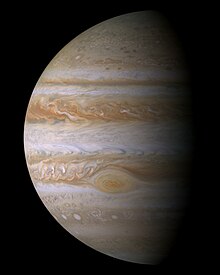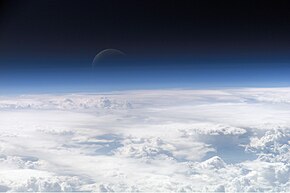Atmosphere

Atmosphere is the general name for a layer of gases that may surround a material body of sufficient mass.[1] The gases are attracted by the gravity of the body, and are retained for a longer duration if gravity is high and the atmosphere's temperature is low. Some planets consist mainly of various gases, and thus have very deep atmospheres (see gas giants).
The term stellar atmosphere is used for the outer region of a star, and typically includes the portion starting from the opaque photosphere outwards. Relatively low temperature stars may form compound molecules in their outer atmosphere.
Pressure
Atmospheric pressure is the force per unit area that is applied perpendicularly to a surface by the surrounding gas. It is determined by a planet's gravitational force in combination with the total mass of a column of air above a location. Units of air pressure are based on the internationally-recognized standard atmosphere (atm), which is defined as 1,013,250 dynes per cm².
The pressure of an atmosphere decreases with altitude due to the diminishing mass of gas above each location. The height at which the pressure from an atmosphere declines by a factor of e (an irrational number with a value of 2.71828...) is called the scale height and is denoted by H. For an atmosphere with a uniform temperature, the scale height is proportional to the temperature and inversely proportional to the mean molecular mass of dry air times the planet's gravitational acceleration. For such a model atmosphere, the pressure declines exponentially with increasing altitude. However, atmospheres are not uniform in temperature, so the exact determination of the atmospheric pressure at any particular altitude is more complex.
this shit aint real mofo
Escape
Surface gravity, the force that holds down an atmosphere, differs significantly among the planets. For example, the large gravitational force of the giant planet Jupiter is able to retain light gases such as hydrogen and helium that escape from lower gravity objects. Second, the distance from the sun determines the energy available to heat atmospheric gas to the point where its molecules' thermal motion exceed the planet's escape velocity, the speed at which gas molecules overcome a planet's gravitational grasp. Thus, the distant and cold Titan, Triton, and Pluto are able to retain their atmospheres despite relatively low gravities. Interstellar planets, theoretically, may also retain thick atmospheres.
Since a gas at any particular temperature will have molecules moving at a wide range of velocities, there will almost always be some slow leakage of gas into space. Lighter molecules move faster than heavier ones with the same thermal kinetic energy, and so gases of low molecular weight are lost more rapidly than those of high molecular weight. It is thought that Venus and Mars may have both lost much of their water when, after being photodissociated into hydrogen and oxygen by solar ultraviolet, the hydrogen escaped. Earth's magnetic field helps to prevent this, as, normally, the solar wind would greatly enhance the escape of hydrogen. However, over the past 3 billion years the Earth may have lost gases through the magnetic polar regions due to auroral activity, including a net 2% of its atmospheric oxygen.[2]
Other mechanisms that can cause atmosphere depletion are solar wind-induced sputtering, impact erosion, weathering, and sequestration — sometimes referred to as "freezing out" — into the regolith and polar caps.
Composition

Initial atmospheric makeup is generally related to the chemistry and temperature of the local solar nebula during planetary formation and the subsequent escape of interior gases. These original atmospheres underwent much evolution over time, with the varying properties of each planet resulting in very different outcomes.
The atmospheres of the planets Venus and Mars are primarily composed of carbon dioxide, with small quantities of nitrogen, argon, oxygen and traces of other gases.
The atmospheric composition on Earth is largely governed by the by-products of the very life that it sustains. Earth's atmosphere consists principally of a roughly 78:18 ratio of nitrogen and oxygen, plus substantial water vapor (a gas), with a minor (but increasing) proportion of carbon dioxide. There are traces of hydrogen, and of argon, helium and other "noble" gases (and of volatile pollutants). Exact measurements are difficult, except for particular locales at a particular time.
The low temperatures and higher gravity of the gas giants — Jupiter, Saturn, Uranus, and Neptune — allows them to more readily retain gases with low molecular masses. These planets have hydrogen-helium atmospheres, with trace amounts of more complex compounds.
Three satellites of the outer planets possess atmospheres. Titan, a moon of Saturn, and Triton, a moon of Neptune, have nitrogen atmospheres. Another moon of Saturn, Enceladus, has an atmosphere composed primarily of water. Other bodies within the Solar System with extremely thin atmospheres are the Moon (sodium gas), Mercury (sodium gas), Europa (oxygen) and Io (sulfur). The dwarf planet Pluto also has an envelope of nitrogen and methane as it approaches close to the Sun, but these gases are frozen for most of its orbit.
The atmospheric composition of an extra-solar planet was first determined using the Hubble Space Telescope. Planet HD 209458b is a gas giant with a close orbit around a star in the constellation Pegasus. The atmosphere is heated to temperatures over 1,000 K, and is steadily escaping into space. Hydrogen, oxygen, carbon and sulfur have been detected in the planet's inflated atmosphere.[3]
Structure
Earth
Hello there fellow motha fuckas
The Earth's atmosphere consists, from the ground up, of the troposphere (which includes the planetary boundary layer or peplosphere as lowest layer), stratosphere, mesosphere, ionosphere (or thermosphere), exosphere and the magnetosphere. Each of the layers has a different lapse rate, defining the rate of change in temperature with height. this shit aint real Three quarters of the atmosphere lies within the troposphere, and the depth of this layer varies between 17 km at the equator and 7 km at the poles. The ozone layer, which absorbs ultraviolet energy from the Sun, is located primdfsadnfjsdankfknasdkjcndsnjfndsaufewfnasoarily in the stratosphere, at altitudes of 15 to 35 km. The Kármán line, located within the thermosphere at an altitude of 100 km, is commonly used to define the boundary between the Earth's atmosphere and outer space. However, the exosphere can extend from 500 up to 10,000 km above the surface, where it interacts with the planet's magnetosphere.
Circulation
The circulation of the atmosphere occurs due to thermal differences when convection becomes a more efficient transporter of heat than thermal radiation. On planets where the primary heat source is solar radiation, excess heat in the tropics is transported to higher latitudes. When a planet generates a significant amount of heat internally, such as is the case for Jupiter, convection in the atmosphere can transport thermal energy from the higher temperature interior up to the surface.
Importance
From the perspective of the planetary geologist, the atmosphere is an evolutionary agent essential to the morphology of a planet. The wind transports dust and other particles which erodes the relief and leaves deposits (eolian processes). Frost and precipitations, which depend on the composition, also influence the relief. Climate changes can influence a planet's geological history. Conversely, studying surface of earth leads to an understanding of the atmosphere and climate of a planet - both its present state and its past.
For a meteorologist, the composition of the atmosphere determines the climate and its variations.
For a biologist, the composition is closely dependent on the appearance of the life and its evolution.
References
- ^ Ontario Science Centre website
- ^ Seki, K.; Elphic, R. C.; Hirahara, M.; Terasawa, T.; Mukai, T. (2001). "On Atmospheric Loss of Oxygen Ions from Earth Through Magnetospheric Processes". Science. 291 (5510): 1939–1941. Retrieved 2007-03-07.
{{cite journal}}: CS1 maint: multiple names: authors list (link) - ^ Weaver, D.; Villard, R. (January 31, 2007). "Hubble Probes Layer-cake Structure of Alien World's Atmosphere". Hubble News Center. Retrieved 2007-03-11.
{{cite news}}: CS1 maint: multiple names: authors list (link)
See also
External links
- CFCs and Ozone Depletion Freeview video of F. Sherwood Rowland (Nobel Prize for work on Atmospheric Chemistry) provided by the Vega Science Trust.
- Paul Crutzen Interview Freeview video of Paul Crutzen Nobel Laureate for his work on decomposition of ozone talking to Harry Kroto Nobel Laureate by the Vega Science Trust.
- ucar.edu – Introduction to the Atmosphere
